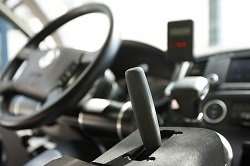Innovative steering system meets the needs of the disabled and autonomous driving

Current adaptable systems that enable people with physical disabilities to drive compare poorly with conventional vehicle controls like steering wheels. An EU initiative has addressed this challenge.
The physically impaired may be unable to drive cars with a standard steering wheel, depending on the type of disability, and need a customised input device like a joystick. These driving solutions are based on drive-by-wire technology that consists of man-machine interfaces (MMIs) and safe electronic driving systems. With drive-by-wire technology, the steering input is transformed entirely by hardware and software without the mechanical fallback of the steering column. Also, driving is facilitated by individually adapted MMIs like joysticks and handlebars.
Often, driving systems are unable to match the performance and feedback of conventional controls. Technical problems, such as time lag and interference between commands, also exist. The car doesn't usually react exactly to the driver's expectations, especially due to the missing active force feedback on the input device. As a result, learning to drive an adapted car is difficult and time consuming. These factors create a need for adaptable systems that can provide dependable and user-friendly driving solutions.
The EU-funded project Joysteer 3.0 "developed a novel drive-by-wire system offering the best driveability, safety and reliability standards to individuals with severe physical limitations," says project coordinator Matthias Hell. "This enables people with a wide range of disabilities, such as muscle paralysis, and arm and leg malformations, to operate a car easily and safely."
Thanks to the various individually adjustable control elements, the Joysteer 3.0 system offers more advantages than traditional vehicle steering aids. Handbrake, automatic gear changing, lights, indicators and windscreen wipers can be easily controlled with just one system and a small number of input devices.
Active force feedback and adaptable steering
Joysteer 3.0 is the only system with active and dynamic force feedback, providing a safe and relaxed driving experience as a result. This feature gives the driver full control of the vehicle from the start, in combination with the highest safety standards.
"The most significant achievements of the project included the elimination of the limitations in the previous version of the product," continues Hell. "Being flexible on demand is crucial to the automotive market. Functions like remote access, remote service and data gathering were key factors in improving the product."
Dual-redundancy systems for safety
Safety is the cornerstone of Joysteer 3.0. There are always two independent branches ensuring a full redundancy of steering and braking. At least one of the systems guarantees the continuity of safe operation and driveability, even in the case of a technical failure.
The drive-by-wire technology also serves as a basis for autonomous driving. This means there's no steering column. Since there's no driver anymore, the commands are given by a computer that's responsible for the trajectories. Joysteer 3.0 transfers the GPS and sensor data to the wheels with minimum latencies and maximum dynamics.
"Joysteer's high modularity addresses this new market segment for autonomous car applications," concludes Hell. "The ultimate aim was to provide advanced, safe and validated solutions for people with disabilities and automated driving, and Joysteer 3.0 has achieved that."
Provided by CORDIS




















